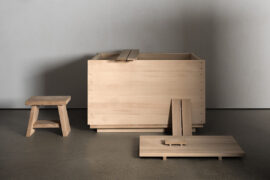This library’s design aims to elevate the student experience and offer something extraordinary. Gillian Serisier interviews Hames Sharley and Schmidt Hammer Lassen about the design.

September 4th, 2023
Far from the traditional library typology is Hames Sharley and Schmidt Hammer Lassen’s design for the TL Robertson Library. Located in Perth, the library has been commissioned by Curtin University, itself a university that works at the cutting edge of national or international research projects in minerals and energy, data analytics, sustainable development, health sciences, agriculture and astronomy.
The library’s design aims to elevate the student experience and offer something extraordinary. As such, the final stage of work responds directly to the research conducted by the design team. This detailed analysis of how the university used the library and broader campus ensures the building functions within place and context – now and into the future.

The transformation, for example, included an expansive flexible learning and event space on the newly created Level 7: “A prominent feature, and a new landmark on the campus, is the dramatic ‘Lantern’ on top of the southern tower. With views south through the treetops, the Lantern space can accommodate a variety of functions of up to 200 people.
“The more-than-2,200 square metres of multi-functional space, with views across the campus to the city, has been created where mechanical plant was formerly located,” says James Edwards, Hames Sharley portfolio leader for education, science and research.
Related: Geological wonderland at Curtin University

Off the back of the research it was determined essential to reposition the library as a hub of knowledge exchange and fulcrum within a contemporary campus. Key to this was design led social connection and a sense of community: “This is reflected in the project’s design elements – the innovative ‘click and collect’ compactus system is a defining feature, where the library’s seven kilometres of physical books are now stored on electronically operated compactus shelving in an environmentally controlled space.
“Consolidating the printed collections in this way released a further 1,000 square metres for flexible study use,” says Edwards of the innovation that sees the entire collection universally accessible. “As a result, most of the library is now dedicated to connection and collaboration, including flexible teaching spaces, individual and group study areas, a ‘Makerspace’ for creative activities and an AV-production room for content creators,” he says.

The design moreover, marks a major departure from the original 1972 Brutalist building, where the key function was as repository for books and physical collections. With low ceilings and few windows, ideal conditions for books, but not for people, the primary aim had been to protect books from sunlight.
As such, the changes have been significant in expanding the library’s floorspace to more than 21,000 square metre, plus a 400 square metre external study terrace. The amount of glazing has doubled, while internally, sections of the existing concrete skin have been peeled away to draw in natural light and allow views: “Ceilings have been removed to bring volume into spaces, while a palette of wood and glass adds to the sense of connection with nature and the surrounding environment,” Edwards says.
Related: Designing for biodiversity at Flinders University in South Australia

In keeping with Curtin University’s tenets, the project was through collaboration that directly responded to the needs of the students, staff and the wider community: “Given its prominence as the most visited place on campus, the scope of this project extended far beyond the replacement of end-of-life services, to a highly complex transformation to create spaces and facilities that respond to the needs of the broader Curtin community,” says Tim Urquhart, director of properties, facilities and development at Curtin University.
He adds: “We have been impressed with how all parties have worked together to achieve this outstanding re-creation of this 50-year-old building to deliver a place of innovation and social collaboration.”

One of the largest library buildings in Australia, the TL Robertson Library can now seat more than 3,000 people in a wide variety of study spaces.
The works also included the finishing touches to the building’s exterior, including the completion of the new, naturally weathered perforated steel facades, which protect the building’s new glazing, entry canopies and roof.

Landscaping works were also completed, creating a new forecourt and external study spaces to the north, which further support the library’s focus on bringing people together. Modifications to Sir Charles Court Promenade and Henderson Court to the south have improved access to the library at all levels and addressed contemporary compliance requirements.
“The new outdoor terrace on Level 4 provides further study opportunities in a secure external environment, surrounded by nature,” says Edwards.

Hames Sharley
hamessharley.com.au
Schmidt Hammer Lassen
shl.dk
Photography
Dion Robeson






INDESIGN is on instagram
Follow @indesignlive
A searchable and comprehensive guide for specifying leading products and their suppliers
Keep up to date with the latest and greatest from our industry BFF's!

For those who appreciate form as much as function, Gaggenau’s latest induction innovation delivers sculpted precision and effortless flexibility, disappearing seamlessly into the surface when not in use.

At the Munarra Centre for Regional Excellence on Yorta Yorta Country in Victoria, ARM Architecture and Milliken use PrintWorks™ technology to translate First Nations narratives into a layered, community-led floorscape.

In an industry where design intent is often diluted by value management and procurement pressures, Klaro Industrial Design positions manufacturing as a creative ally – allowing commercial interior designers to deliver unique pieces aligned to the project’s original vision.

Jason Gibney, winner of the Editor’s Choice Award in 2025 Habitus House of the Year, reflects on how bathroom rituals might just be reshaping Australian design.

J.AR OFFICE’s Norté in Mermaid Beach wins Best Restaurant Design 2025 for its moody, modernist take on coastal dining.
The internet never sleeps! Here's the stuff you might have missed

Jason Gibney, winner of the Editor’s Choice Award in 2025 Habitus House of the Year, reflects on how bathroom rituals might just be reshaping Australian design.

Located in the former Madam Brussels rooftop, Disuko reimagines 1980s Tokyo nightlife through layered interiors, bespoke detailing and a flexible dining and bar experience designed by MAMAS Dining Group.

Designed by RADS, the space redefines the lobby not as a point of passage, but as a destination in itself: a lobby bar, a café, and a small urban hinge-point that shapes and enhances the daily rituals of those who move through it.

At the Munarra Centre for Regional Excellence on Yorta Yorta Country in Victoria, ARM Architecture and Milliken use PrintWorks™ technology to translate First Nations narratives into a layered, community-led floorscape.